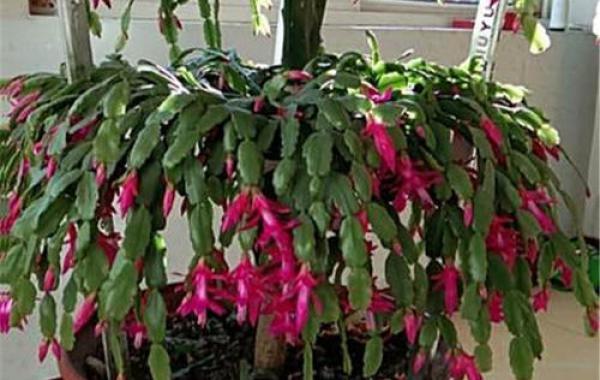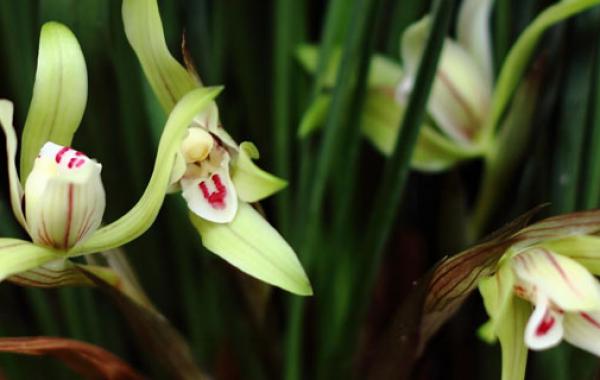How to manage the florescence of crab claw orchid

The flowering period of crab claw orchid is generally from October to February of the following year. It is necessary to strengthen the daily management during the flowering period of crab claw orchid. Let me introduce the management methods of crab claw orchid florescence.
First, heat preservation and gloss
Crab claw orchid likes the warm environment, the indoor temperature should be kept between 14-20 ℃ in winter, the flower bud can not develop normally if the temperature is too low, if it is lower than 5 ℃ for a long time, it is easy to make the plant die from freezing injury, the temperature is too high, and it is easy to shorten the flowering period.
Although the crab claw orchid is a short-day plant, it is necessary to strengthen the light during the flowering period. It should be placed on the south windowsill with plenty of light as far as possible indoors, and the flowerpot should be turned every seven days in order to make the plant grow flowers evenly. If the indoor light is seriously insufficient or continuous cloudy days, fluorescent lamps can be used to make up the light. The method is to turn on the lights every evening for 3-4 hours to make the flowers bloom normally.
Second, controlling water and stopping fertilizer
Crab claw orchid is particularly sensitive to water at flowering stage, which is easy to drop buds, and seriously makes rootstocks rot roots and lead to plant death; lack of water is easy to make flowers wilt and buds can not develop and mature. The correct method is: keep the basin soil in a slightly wet state, it is appropriate to pinch it by hand, and spray with the same water as the indoor temperature at noon every day, so that you can get twice the result with half the effort. If the basin soil is too dry, it can not be watered at once, but can be watered step by step. Too much watering at one time will make the plant drop buds and stems.
Crab claw orchid likes fertilizer, and its growth period can be fertilized according to the principle of frequent application of thin fertilizer, but generally speaking, fertilization should be stopped when the bud is basically formed. Fertilization during this period can easily lead to plant buds falling.
Third, ventilation and insect prevention
It is important for crab claw orchid to keep warm indoors in winter, but ventilation should not be ignored. Poor ventilation can easily cause diseases and insect pests, so the doors and windows should be properly opened at noon in sunny weather for ventilation; the main pests of crab claw orchid at flowering stage are aphids and shell pests, in addition to paying attention to ventilation, if they occur, they can be caught manually when the number is small, and when the number is large, 1000 times of omethoate EC can be used to spray.
The flowering period of crab claw orchid (crab claw lotus) is generally from November to January of the following year, during which the management is particularly important, which directly affects the quality of flowering and post-anthesis dormancy. After years of practice, the author summed up a set of flowering management technology of crab claw orchid, which is introduced as follows for the majority of flower friends' reference.
1. Controlling water and stopping fertilizer
Crab claw orchid is particularly sensitive to water at flowering stage, which is easy to drop buds, and seriously makes rootstocks rot roots and lead to plant death; lack of water is easy to make flowers wilt and buds can not develop and mature. The correct method is: keep the basin soil in a slightly wet state, it is appropriate to pinch it by hand, and spray with the same water as the indoor temperature at noon every day, so that you can get twice the result with half the effort. If the basin soil is too dry, it can not be watered at once, but can be watered step by step. Too much watering at one time will make the plant drop buds and stems.
Crab claw orchid likes fertilizer, and its growth period can be fertilized according to the principle of frequent application of thin fertilizer, but generally speaking, fertilization should be stopped when the bud is basically formed. Fertilization during this period can easily lead to plant buds falling.
Second, heat preservation and gloss enhancement
Crab claw orchid likes the warm environment, the indoor temperature should be kept between 14-20 ℃ in winter, the flower bud can not develop normally if the temperature is too low, if it is lower than 5 ℃ for a long time, it is easy to make the plant die from freezing injury, the temperature is too high, and it is easy to shorten the flowering period.
Although the crab claw orchid is a short-day plant, it is necessary to strengthen the light during the flowering period. It should be placed on the south windowsill with plenty of light as far as possible indoors, and the flowerpot should be turned every seven days in order to make the plant grow flowers evenly. If the indoor light is seriously insufficient or continuous cloudy days, fluorescent lamps can be used to make up the light. The method is to turn on the lights every evening for 3-4 hours to make the flowers bloom normally.
Third, ventilation and insect prevention
It is important for crab claw orchid to keep warm indoors in winter, but ventilation should not be ignored. Poor ventilation can easily cause diseases and insect pests, so the doors and windows should be properly opened at noon in sunny weather for ventilation; the main pests of crab claw orchid at flowering stage are aphids and shell pests, in addition to paying attention to ventilation, if they occur, they can be caught manually when the number is small, and when the number is large, 1000 times of omethoate EC can be used to spray.
- Prev

Gentleman orchid has been raised for several years, why not blossom?
Gentleman orchid has been raised for several years, why not blossom?
- Next

The difference between Orchid tissue Culture plantlets and Primary plantlets
The difference between Orchid tissue Culture plantlets and Primary plantlets
Related
- Is the orchid suitable for indoor use? Is it good for the body?
- How to prevent the empty root of orchids?
- What to do after the crab claw orchid is withered?
- Why are the leaves of orchids always yellow? Fertilizing and watering.
- Can the root of the gentleman orchid be saved if it is rotten?
- Diagnosis and treatment of cotton-blowing beetle insects in Cymbidium
- There is a way for a gentleman's orchid to rot.
- What is the most suitable temperature and humidity for the orchid?
- How to raise a gentleman's orchid? Cultivation techniques of Cymbidium
- How to prepare the nutritive soil for the cultivation of Cymbidium

